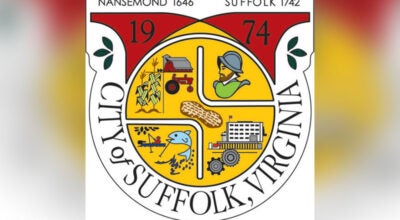Students hold on for dear wildlife
Published 11:13 pm Thursday, September 20, 2018
Seventh-graders at John Yeates Middle School enjoyed a break from their usual science classes when they held aquatic critters fresh out of Suffolk waterways on Thursday.
The Nansemond River Preservation Alliance held programs for approximately 120 JYMS seventh-graders during Thursday classes. They watched a video called “The Incredible Oyster Reef” by the Chesapeake Bay Foundation, then got to work with both water quality activities and the Chesapeake Bay creatures that depend on their habitats being well kept.
There were five different stations in seventh-grade science teacher Deborah Askew’s classroom. Students learned how to measure turbidity and amounts of pH and dissolved oxygen in water samples with an array of instruments, all under careful supervision from Cindy Pinell and Karla Smith with NRPA.
But the students’ favorite part was getting up close to tubs filled with critters collected from local waterways earlier that morning. One tub had more than 1,000 oysters, and students took a few out to measure their sizes. Some were just a few inches wide and others had conjoined to make solid, rock-like masses of oysters stuck together.
Those sturdy oyster groupings had dozens of tiny mud crabs crawling all over them.
“Look how many crabs are under this thing,” Dion Harris, 12, said as he held one up. “It’s like the thing is made out of crabs.”
The tubs had more than 40 different species, Pinell said, including skilletfish, naked gobi fish and the elusive feather blennies.
“(The feather blenny) is more secretive and rarer,” Pinell said. “We don’t always get them.”
Other students were faced with much larger blue crabs that skittered around their tub. Many of these blue crabs were molting, and each of their shells felt like soft, wet paper.
When the time is right they’ll leave their old shells behind as “shed.”
“The kids always say, ‘That one’s dead,’” Pinell said about the old, empty shell. “We always have to reiterate, ‘No, that’s its shed.’”
NRPA members have spent the past several years conducting these programs in seventh-grade classrooms in Suffolk middle schools. Smith, Pinell, Mike Reiss and NRPA President Elizabeth Taraski reach out to provide experiences that encourage students to learn more about their environment.
“They learn so much better when they can touch, feel, see and smell everything,” Askew said. That includes some student highlights like their boat trips with the NRPA.
The goal is to train the young girls and boys to become tomorrow’s environmental stewards, a process that doesn’t stop in middle school. According to Smith, being a good caretaker for the environment means being a good student indefinitely.
“The older I get, the more I know I don’t know anything,” she said.
“I have a sign in my house that says ‘I’m too young to know everything,’” Pinell added.






